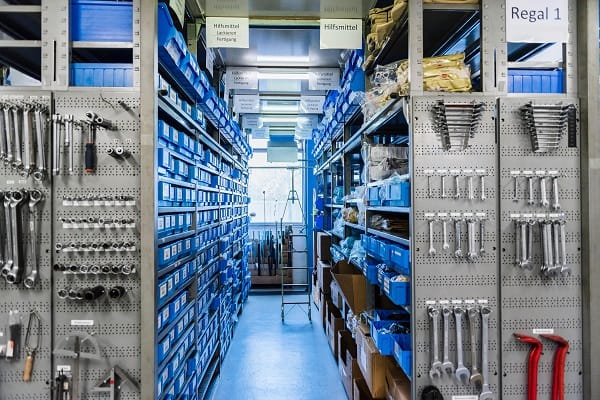In today’s market, where speed and efficiency are paramount, the role of warehouse operations can’t be overstated. With e-commerce growth and complex supply chains, finding the right strategies for warehouse efficiency is crucial.
From innovative uses of floor markings to leveraging smart storage solutions, achieving operational excellence involves a mix of technology, layout optimisation, and data analytics. These steps are essential for keeping pace with demand and ensuring a smooth, efficient process that supports the broader goals of businesses.
Adopt advanced warehouse management systems (WMS)
Embracing technology lies at the heart of modernising warehouse operations. Advanced Warehouse Management Systems (WMS) play a pivotal role in revolutionising inventory management, order processing, and overall logistical coordination. By automating tasks traditionally done by hand, WMS not only streamlines operations but also significantly reduces the potential for human error.
This technology offers real-time data, enabling more precise forecasting, efficient resource use, and a seamless goods flow. Integrating a WMS into warehouse operations marks a leap towards a more agile, responsive, and efficient workflow.
Utilise smart storage solutions
Maximising efficiency in a warehouse often hinges on the clever use of space. Innovative storage solutions, including vertical storage and automated retrieval systems, play a crucial role. These technologies enable warehouses to fully leverage vertical space and automate the process of retrieving items, which in turn optimises the use of floor space.
Not only do these smart storage options streamline the organisation and retrieval of inventory, but they also contribute to a reduction in retrieval times and improve overall inventory control. By adopting such advanced storage strategies, warehouses can significantly enhance operational efficiency, ensuring they are well-equipped to meet both current and future demands.
Optimise layout and flow
The efficiency of a warehouse is greatly influenced by its layout. An intelligently designed layout ensures a smooth flow of goods and staff, minimising bottlenecks and enhancing safety. Placing high-demand items closer to dispatch areas reduces travel time, accelerating the order fulfilment process.
Moreover, clearly marked aisles and zones not only aid in quicker navigation but also bolster safety standards. Periodically reviewing and tweaking the warehouse layout to adapt to shifts in inventory levels and order trends can significantly boost efficiency, optimising every square metre of space.
Floor markings for safety and efficiency
Floor markings stand as silent guardians of safety and orchestrators of efficiency in the warehouse environment. By clearly defining walkways, forklift lanes, and specific zones for storage, picking, or shipping, they significantly reduce accident risks and streamline operational flow.
The effectiveness of these markings hinges not just on their placement but also on their visibility and durability. Different colours serve various purposes: yellow for pathways, red for hazard areas, and blue for material storage, each colour conveying critical information at a glance.
For warehouses looking to implement or refresh their floor marking system, choosing the right paint is as crucial as the colour scheme itself. It’s essential to opt for paints that promise longevity and stand up to the rigorous demands of warehouse traffic. You can find exactly what you need for your warehouse flooring with a range of industrial floor paints and colours from Regal Paint. Their quick-drying, anti-slip paint can help keep your commercial area a safe, efficient, and well-organised space.
Invest in employee training and incentivisation
Enhancing warehouse efficiency significantly hinges on investing in employee training and incentivisation. Proper training equips staff with the necessary skills to operate efficiently and safely, reducing errors and accidents. Beyond training, offering incentives for performance excellence motivates employees to excel in their roles.
Whether through bonuses, recognition, or career advancement opportunities, incentivised employees are likely to contribute to a more productive and positive warehouse environment. Such investments not only improve individual performance but collectively elevate the operational efficiency of the warehouse, demonstrating the profound impact of valuing and developing the workforce.
Utilise data and analytics for continuous improvement
Leveraging data and analytics marks a transformative step towards optimising warehouse operations. By meticulously collecting and analysing data on various aspects of warehouse performance, such as inventory turnover rates, picking accuracy, and shipping times, managers can uncover insights into where improvements can be made. This data-driven approach enables the identification of inefficiencies and bottlenecks that may not be immediately apparent.
Implementing analytics tools can help predict trends, optimise inventory levels, and enhance decision-making processes, leading to more streamlined operations. Regular reviews of data analytics encourage a culture of continuous improvement, where every process is scrutinised for potential enhancements.






Leave a Comment